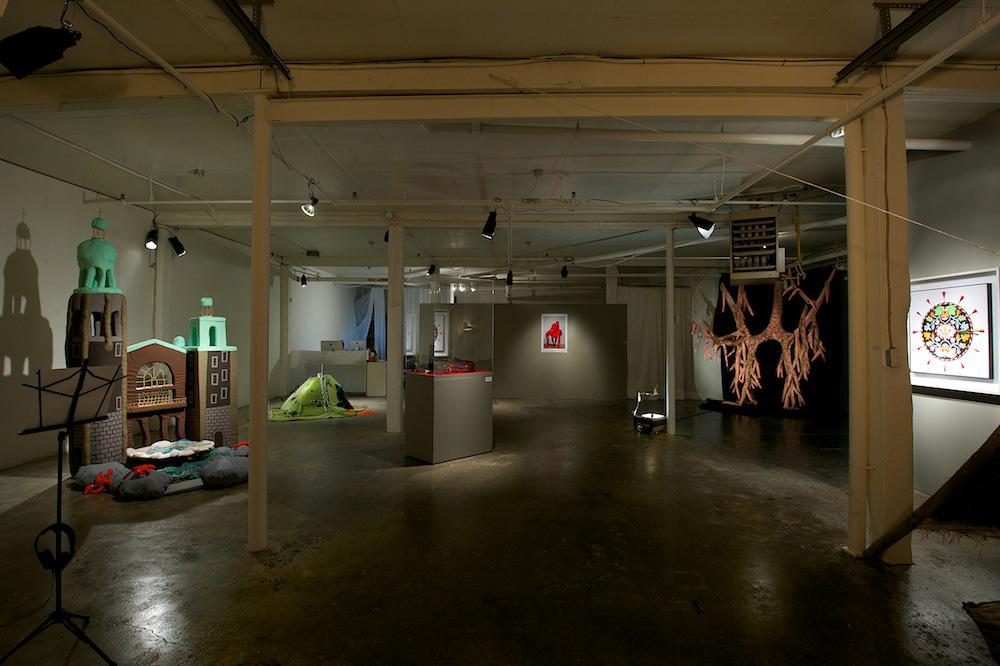The Modernist “white cube” has been so thoroughly critiqued that any further comment on the subject feels slightly pointless. This does not change the fact that the vast majority of contemporary exhibition spaces continue to adhere faithfully to its dictates. Even when projects questioning its logic are mounted, they often merely serve to reaffirm its authority, as when public museums attempt to transform themselves into loci for spontaneous happenings and ad hoc artistic “assemblages.” Despite celebrating unorthodoxy, such projects do little to actually change the institutional frameworks upon which they necessarily depend. Opportunities for real artistic experimentation—in the basic sense of trying something out and possibly failing—are thus increasingly rare, as expressions of “counterculture” are reduced to clichés of subversion now tacitly ruled by institutional standards of professionalism.
In this climate, an exhibition space that is not pristinely hermetic is a refreshing change. Gallery 101’s new building offers just such welcome relief. Recently relocated to a converted industrial garage in Ottawa’s Little Italy neighbourhood, the 35-year-old artist-run centre now boasts a scrappy exhibition space that makes little attempt to conceal its working-class past. Rather than serving as a neutral backdrop for any exhibition, the idiosyncrasies of the space are, for better or worse, part of the projects realized there. This sometimes results in awkward arrangements, but it also serves to generate unexpected connections and valuable new insights. The exhibition recently on view there provides a good example of this dialectic.
Curated by the gallery’s director/curator, Laura Margita, “Material Witness: Art, Activism and Fibre” explored the nexus of art and activism in the work of five artists whose practices engage with textiles. Organized as part of the Peoples’ Social Forum, held in Ottawa in August to promote activism and grassroots socialist movements in Canada, the exhibition addressed a range of socio-political issues, including decolonization, ecological preservation and identity politics.
At the heart of the exhibition stood a powerful work by Anishinaabe (Odawa) artist Barry Ace. Nigik Makizinan – Otter Moccasins (2014) features a repurposed pair of Fluevog boots adorned with ceremonial otterskin “trail dusters”—an homage to those worn by Plains warriors to wipe away their footprints—as well as the artist’s signature combination of traditional glass beadwork and salvaged computer components. Like much of Ace’s work, it transforms found, discarded and mass-produced materials into an eloquent, vivid expression of cultural endurance undeterred by centuries of colonial oppression and rapid social change.
The tension between creation and destruction highlighted in Ace’s work was echoed in Pieta I (2013), a photograph documenting a performance by Ottawa-based, Serbian-born artist Bozica Radjenovic. In the image, the artist appears wearing a “second skin” knitted from bright-red yarn. Although this garment seems to have been made for two bodies, its second compartment lies empty, draped across the artist’s arms in a clear reference to Michelangelo’s iconic Pietà (1498–99). The subsequent unravelling of the piece during a related performance in the Netherlands in 2013 played upon the double meanings of the word “ravel,” while also encapsulating the artist’s childhood experiences living in a war-torn socialist country.
An important portion of the show was devoted to “sloppy craft” and mixed-media experiments. Montreal-based artist Mona Sharma’s whimsical soft sculptures memorialize significant moments from her life, while also challenging aesthetic stereotypes assigned to her on the basis of her South Asian heritage. Karina Bergmans’s take a deep breath (2014)—a monumental set of bronchial tubes made from Tyvek hazmat suits that inflated and trembled eerily in a corner of the gallery—personifies fears related to global pandemics. And Emily Rose Michaud’s ambitious, although less successful, foray into media-art installation respectfully raises important issues surrounding the conservation of the Gatineau River.
There is symmetry between the politics of this exhibition and the way Gallery 101 is positioning itself vis-à-vis other artist-run spaces in the region. SAW Gallery, for example, is now part of the City of Ottawa’s vaunted Arts Court redevelopment project, and it will take over some of the space currently occupied by the Ottawa Art Gallery when the latter moves into a larger, purpose-built facility in 2017. Meanwhile, AXENÉO7 has enjoyed a renovated space at La Filature for many years. Gallery 101, for its part, seems to have opted for something more at the crossroads of art institution and social practice. Its space—which it now also shares with the Asinabka Film and Media Arts Festival and Niigaan: In Conversation, a community organization that fosters open dialogue between Indigenous peoples and settler Canadians—is indicative of this orientation. Those who dismiss it as unprofessional betray a conservatism at odds with the gallery’s changing vision and mission. And while, as a settler Canadian, it’s not my place to say what a decolonized exhibition space should look like, I have a strong feeling it probably isn’t a perfectly white cube.









